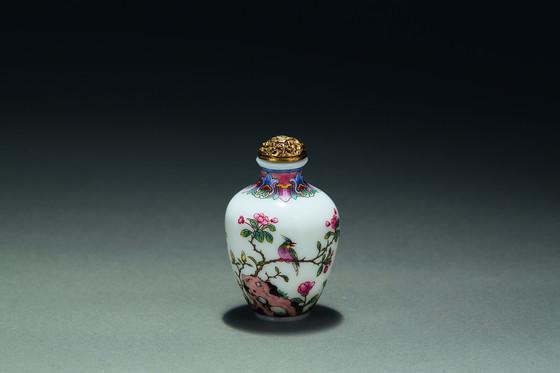In honor of the International Chinese Snuff Bottle Society’s 2016 convention here in Los Angeles, LACMA Curator and Chinese Department Head Stephen Little, with the assistance of local collector and dealer Clare Chu, has organized an exhibition of 200 Chinese snuff bottles from collectors around Southern California. The intricately decorated bottles are grouped by material—glass, porcelain, amber, aquamarine, bamboo, cloisonné, glass, jade, lacquer, and limestone. Some are translucent and painted on the inside, while others are decorated with fossils, porcelain, quartz, rock crystal, tourmaline, and turquoise. Their unique display, designed by LACMA Assistant Director of Exhibition Design and Production Victoria Behner, references grid patterns found in Chinese furniture. “The flexible geometries allowed the curator to set up groupings and relationships within a relatively structured system,” she explains. Throughout the run of the exhibition, we’ll be highlighting the stories behind these coveted artifacts, described by Stephen as “little windows into the culture.”
Below, Stephen discusses Snuff Bottle with Long-Tailed Bird on a Blossoming Tree:
This bottle was made at a time when snuff—a very finely ground tobacco originally from Brazil—was imported into China from Brazil (although they were already growing tobacco in China). When tobacco first appeared in China, it was smoked, but smoking was considered by some of the early Qing dynasty emperors as very low class and smelly. So it became fashionable to take snuff directly—very finely powdered and to sniff it with one’s nose. In Chinese, these are called biyanhu, or “nose smoke bottles.”
This bottle is interesting for a number of reasons. First of all, it’s one of the few in the show that was made for the specific use of an emperor. This has the mark of the Qianlong emperor, who reigned for 60 years (1736–95). It’s made of glass, and almost certainly made in the Forbidden City because there were certain workshops that were designed in the early Qing dynasty for the manufacture of enamels and glassware for the palace. The enamels are painted on top of the glass and then fired separately to fix them to the glass surface. It’s a very small bottle. It’s decorated with birds and a blossoming tree, and a little gold top that holds the spoon that would have been used to take the snuff out of the bottle. So this one is really rare because it’s as fine as they ever get in terms of manufacture and technique. It has a four-character mark on the bottom, inside the foot ring, which says “Made during the reign of Qianlong.” It’s a type that’s copied a lot. Originally enamels like this appear on porcelain. And there are many enameled porcelain bottles at the beginning of this show. But this section here is all enamels on top of glass. You can see that the glass is a wonderful surface because it’s very bright. The enamels are usually opaque, but sometimes translucent, so you get the light coming through them, hitting the glass, and then bouncing back up.
See this bottle and 199 others in Chinese Snuff Bottles from Southern Californian Collectors, on view in the Hammer Building through October 1, 2017. This is excerpted, condensed, and edited from an interview held in November 2016.



